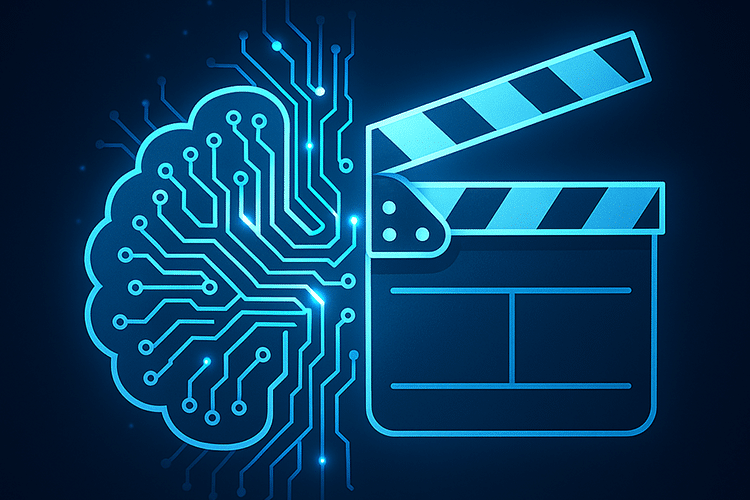Artificial intelligence (AI) is transforming various industries, and cinema is no exception. From scriptwriting to the production of visual effects, AI-based tools are opening new possibilities for filmmakers and audiovisual creators. However, this progress also raises ethical and labor challenges that must be carefully considered. In this article, we explore how AI is used in cinema, its advantages, the challenges it faces, and some real cases where this technology has left its mark.
How Could AI Be Used in Cinema?
AI has the potential to transform multiple stages of the filmmaking process, from pre-production to post-production. Its applications go beyond what we can imagine, opening new ways to improve efficiency, reduce costs, and boost creativity.
Script Support Ideas Using AI Tools
During the writing phase, AI tools like Vondy or Simplified allow us to generate personalized film scripts. For example, we can predefine the script’s length, tone, style, and genre.
Currently, there are many AI tools for scriptwriting, each with specific advantages. Vondy stands out for its ability to capture the emotions of each character in their dialogues.
Visual Effects and Automated Animation
One of the most exciting uses of AI in cinema is creating visual effects and automating animations. Pixar, for example, used AI in their movie Elemental (2023) to animate complex characters like Ember, a being made of fire. AI helped achieve a balance between the natural look of fire and the character’s traits, which would have required much more time and resources if done manually.
Production Process Optimization
AI also helps streamline various aspects of film production, from planning to post-production. Automated tools can handle repetitive tasks such as scene organization or workflow optimization during editing, allowing teams to focus more on the creative side of the project.
Advantages of Artificial Intelligence in the Film Industry
The use of AI in cinema not only improves efficiency but also opens doors to new forms of creativity and artistic expression.
Cost and Time Reduction
Automating certain processes with AI can significantly reduce production costs and shorten delivery times. Instead of spending weeks or months manually creating visual effects or animating characters, AI tools can perform similar tasks in a fraction of the time, enabling more efficient use of resources.
Innovation in Storytelling and Creativity
AI also fosters innovation in storytelling. By analyzing large volumes of data on what attracts audiences, AI can help writers and directors craft more engaging and original stories. Additionally, some tools generate virtual characters and settings, offering infinite possibilities for cinematic narratives.
Challenges of Using AI in Cinema
Although artificial intelligence offers many advantages, its integration into the film industry also faces significant challenges.
Ethics in Using AI for Creativity
One of the biggest debates around AI in cinema concerns the ethics of its application. While AI can be a useful tool, many filmmakers and creators argue that true creativity is human and that AI cannot replicate the passion and dedication required to create genuine art. Furthermore, there are concerns that AI use might dilute the authenticity of film productions.
Risk of Job Loss in the Sector
Another critical challenge is the impact AI could have on employment in the film industry. A study by the United States Animation Guild indicates that by 2026, 21.4% of animation jobs could be affected by automation. This includes positions where AI might replace artists or technicians performing repetitive tasks, creating significant job uncertainty.
Real Cases of AI Applied to Cinema
The debate about AI in cinema goes beyond theory. Numerous real productions have successfully integrated this technology.
Productions That Have Successfully Integrated AI
AI use in cinema is not new. Pixar’s Elemental is a clear example of how AI can enhance the quality of visual effects and animation. Moreover, festivals like Annecy have screened several short and feature films incorporating AI tools. Despite criticism, these works have been accepted because they demonstrate how AI can complement the director’s creative vision rather than replace it.
Examples of Recent Technological Advances
AI has also advanced in audience behavior prediction. Companies like StoryFit have developed tools that analyze scripts and audiovisual content to predict how it might resonate with viewers, providing studios with valuable data to decide which projects to finance or develop.
Furthermore, legislation around AI, such as the new EU regulation effective in 2026, is beginning to regulate its use in the film industry, aiming to protect creators’ rights and sector employment.
AI is transforming the film industry, opening new possibilities and presenting challenges that must be carefully managed. Moving forward, it will be essential to find a balance between leveraging its advantages and protecting human creativity as well as labor rights in cinema.
Would you like to join a group of industry professionals to exchange opinions on AI use in the seventh art? If so, become a member of Clúster, the platform where you can network, stay updated on upcoming events (like the recent launch of FINDE, the first Financing, Investment, and Independent Cinema meeting), and learn about the latest audiovisual market trends.
Author: Redacción Clúster Audiovisual de Madrid
Brandominus
